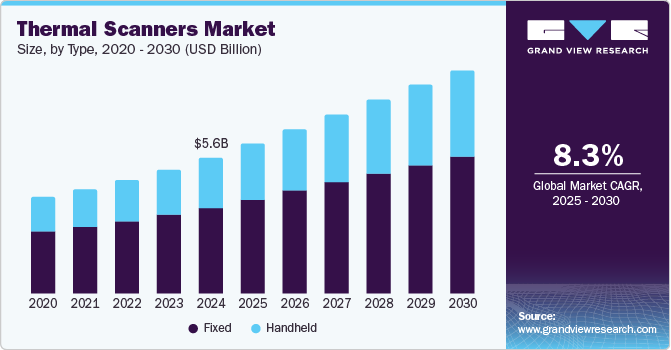Thermal Scanners Market Size, Share & Trends Analysis growing at a CAGR of 8.3% from 2025 to 2030

The global thermal scanners market was valued at USD 5.61 billion in 2024 and is projected to grow at a CAGR of 8.3% from 2025 to 2030. Several key factors are driving the expansion of this market. These include the rising demand for thermal scanners at airports for mass screening, increasing government expenditures globally in the aerospace and defense sectors, and heightened R&D investments by companies, governments, and capital firms to create advanced thermal scanning solutions.
Request a free sample copy or view report summary: https://www.grandviewresearch.com/industry-analysis/thermal-scanners-market/request/rs1
The need for effective fever detection and infection control has led to the widespread adoption of thermal scanners in various settings, including airports, healthcare facilities, and workplaces. This trend is further amplified by government mandates and increased investments in healthcare infrastructure across regions, particularly in Asia-Pacific, where rapid urbanization and industrialization are driving demand for these devices.
Moreover, the increasing integration of thermal scanning technology with advanced systems such as IoT and AI leads to market expansion. This integration heightens the capabilities of thermal scanners, enabling real-time data analytics and remote monitoring, which are essential for effective industrial automation and surveillance applications. For instance, Arrow Electronics introduced an AI thermal sensing solution designed to accelerate the development of health monitoring devices. This integrates AI capabilities with thermal imaging to enable accurate temperature screening in various environments, such as healthcare settings.
Furthermore, the market is benefiting from substantial investments in research and development aimed at creating refined thermal scanning technologies. Despite their higher cost and maintenance requirements, cooled thermal scanners are gaining traction in specialized applications such as military defense and scientific research due to their superior sensitivity and image resolution. As manufacturers strive to enhance product affordability and performance, the competitive landscape is evolving, promising continued growth for the thermal scanners industry in the coming years.
Type Insights
The fixed segment dominated the market with a revenue share of 63.2% in 2024 due to its extensive application in industrial and commercial settings. These scanners are permanently installed, providing continuous monitoring and surveillance, which is crucial for environments that require constant temperature checks, such as manufacturing plants and healthcare facilities. The reliability and accuracy of fixed thermal scanners make them ideal for detecting variances in equipment and ensuring safety compliance. For instance, The Asian Development Bank (ADB), in collaboration with UNICEF, has assisted the Government of India in deploying thermal scanners to facilitate mass screening of passengers at key entry points.
The handheld segment is projected to grow at the highest CAGR during the forecast period, primarily due to its versatility and ease of use. Handheld thermal scanners are favored for their portability, allowing users to conduct temperature screenings in various locations, including public spaces, and during inspections. The demand surged during the COVID-19 pandemic as organizations sought efficient ways to screen individuals without physical contact. This adaptability makes handheld devices increasingly popular for temporary and immediate screening needs across multiple sectors.






